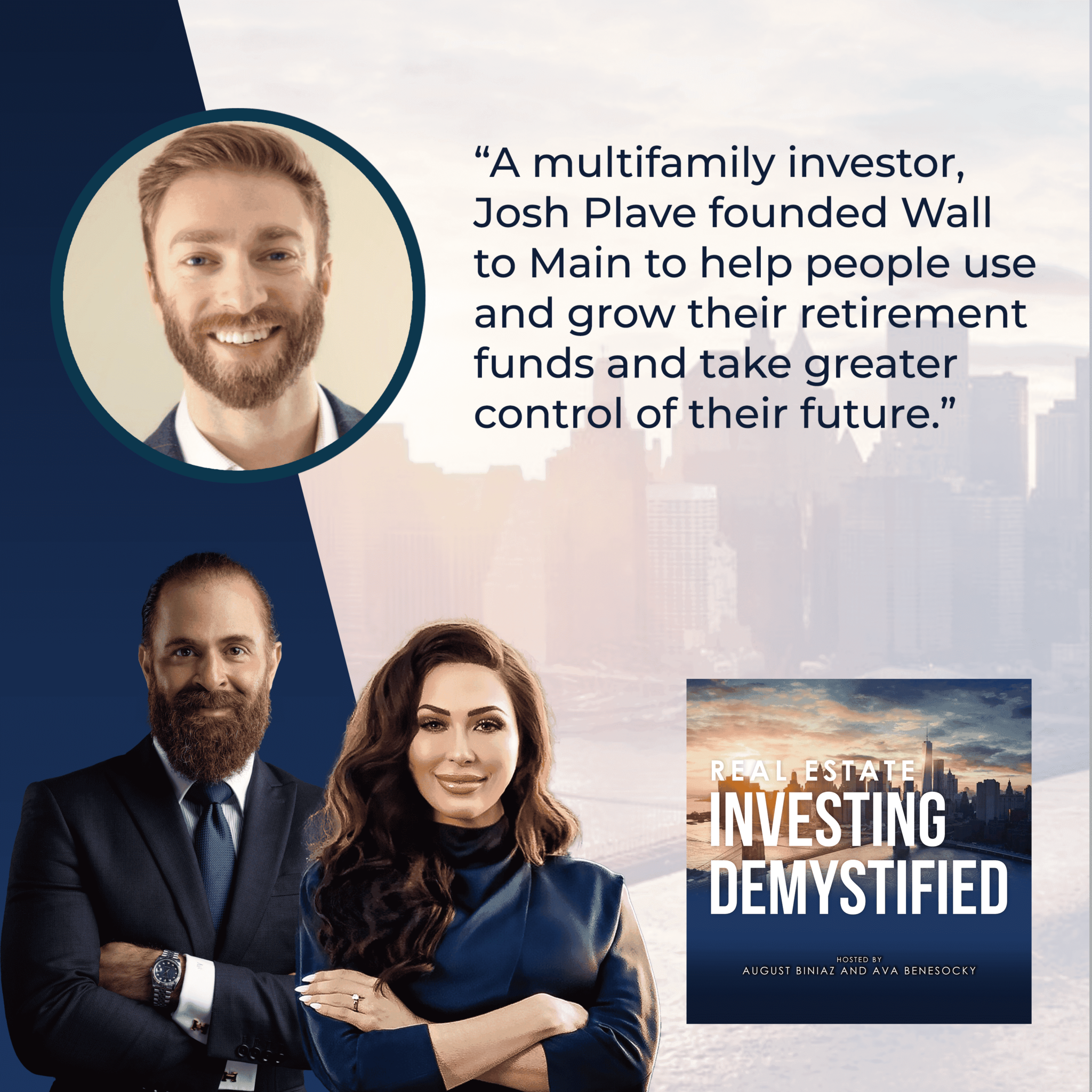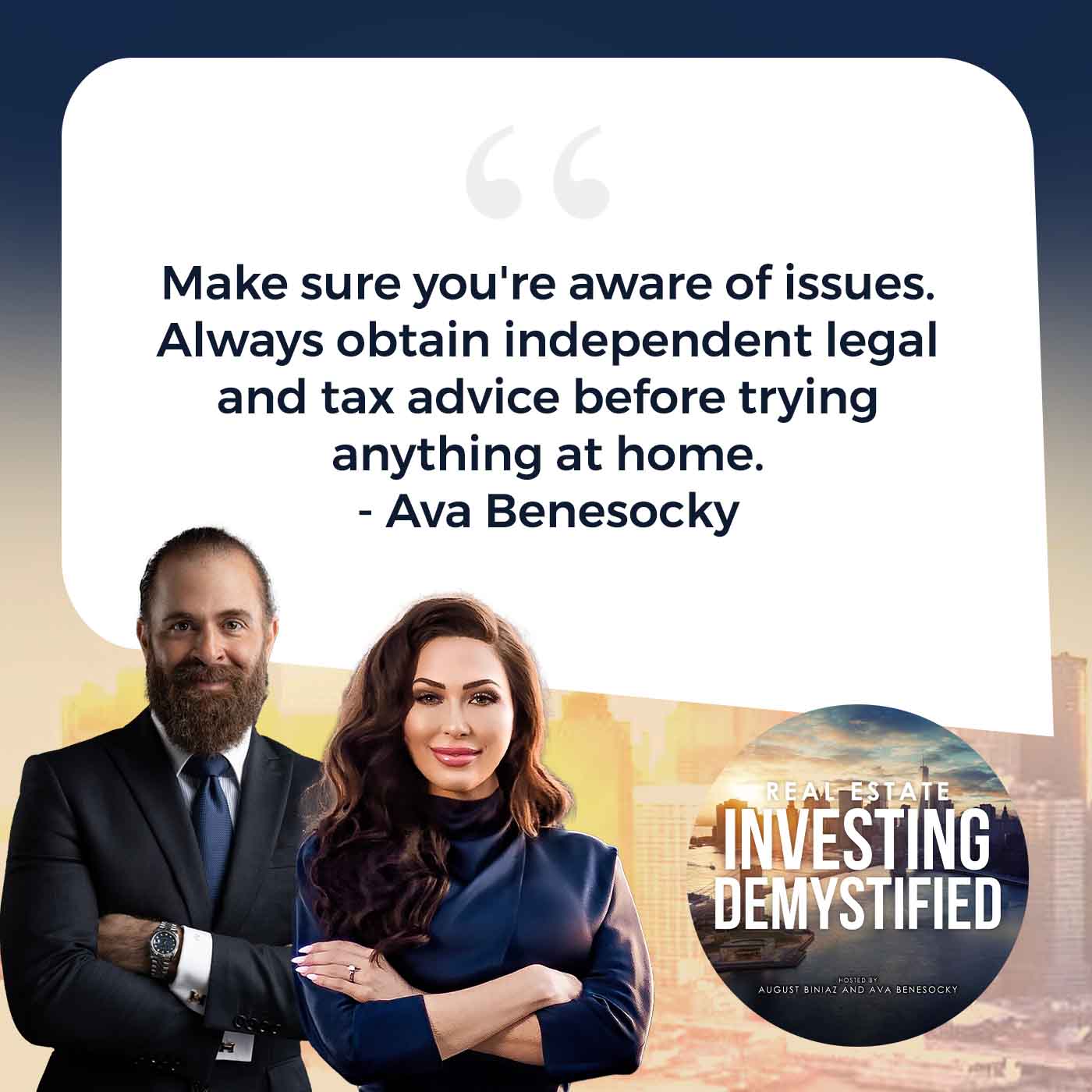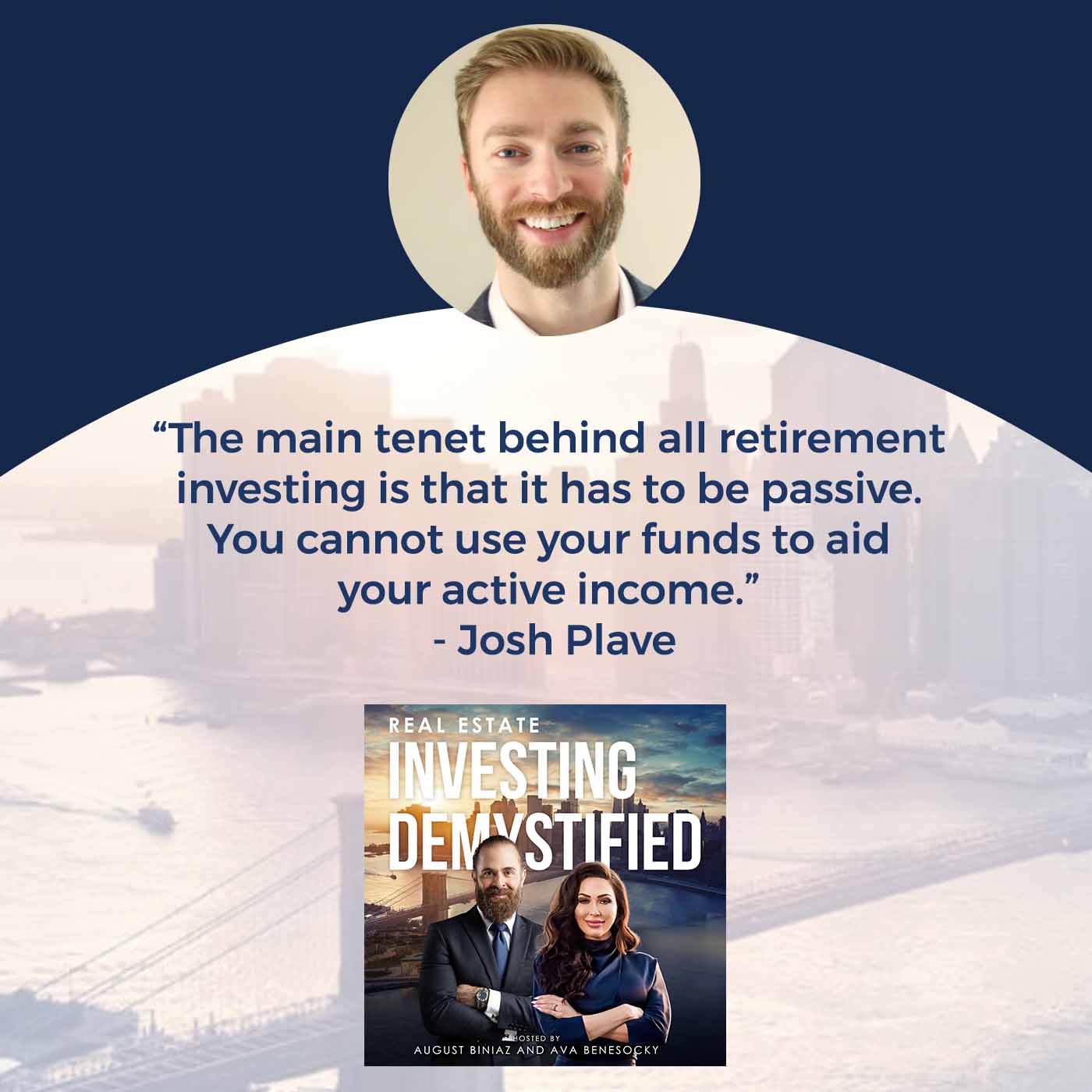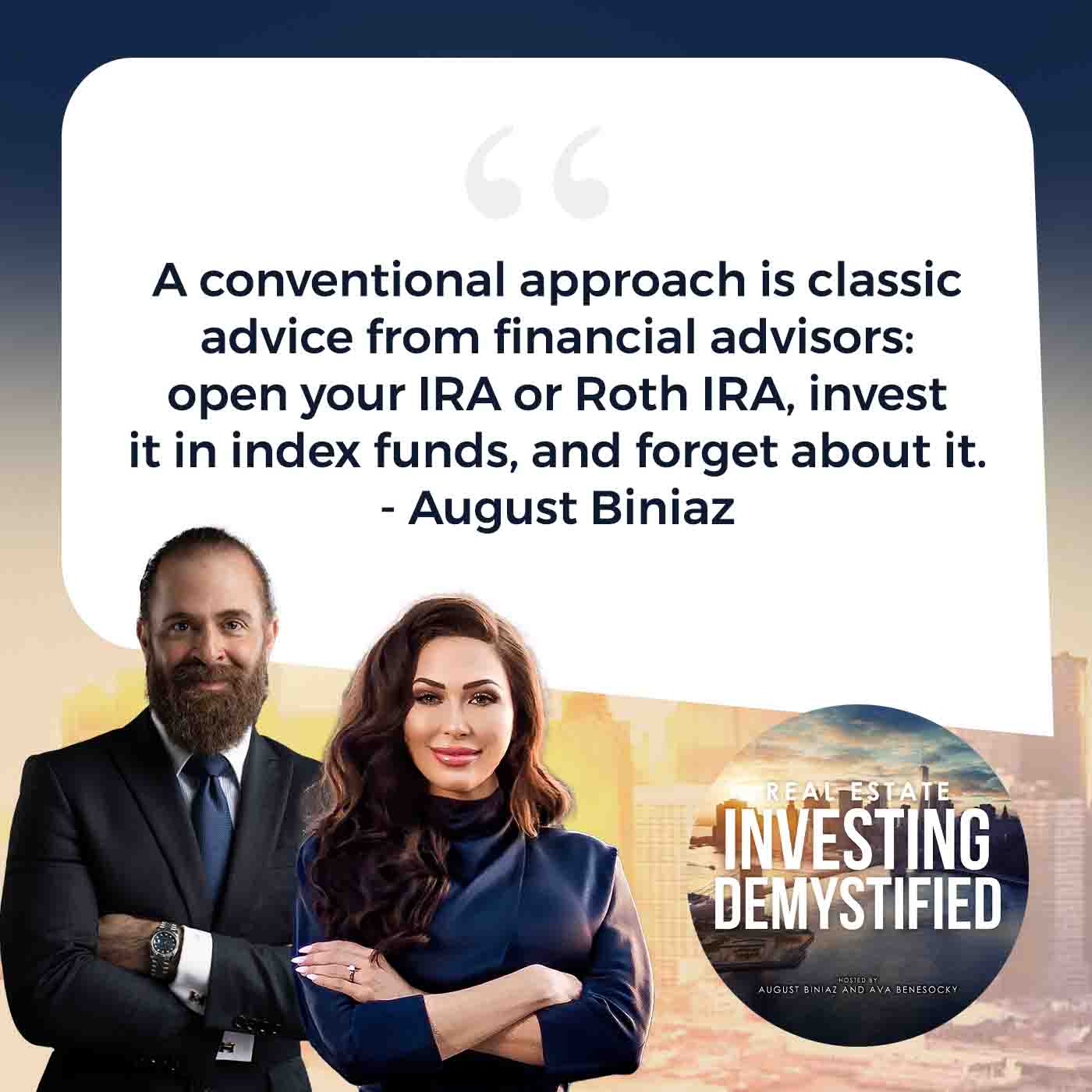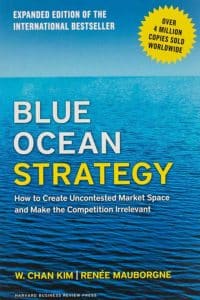Do you want to invest in real estate but don’t have any idea where to get the cash? This episode is for you! Josh Plave, the founder of Wall to Main, shares how you can use your retirement account to get started in real estate. When his mother and grandfather passed, he became a good steward of the retirement account they left for him. Tune in and discover the power in your existing IRA or 401k and how you can use them to invest in real estate.
Get in touch with Josh Plave:
LinkedIn: https://www.linkedin.com/in/joshplave
Website: https://walltomain.com/about/
If you are interested in learning more about passively investing in multifamily & Build-to-Rent properties, click here to schedule a call with the CPI Capital Team or contact us at info@cpicapital.ca. If you like to Co-Syndicate and close on larger deal as a General Partner, click here. You can read more about CPI Capital at https://www.cpicapital.ca/.
#avabenesocky #augustbiniaz #cpicapital
—
Watch the episode here
Listen to the podcast here
Important Links
About Josh Plave

How To Use Your Retirement Account To Get Started In Real Estate – Josh Plave
In this episode, we have another guest and another exciting topic to discuss. Should we get right into it? Is there something else we want to quickly touch on? What’s happening with the world, economy and interest rates?
I keep thinking about how many conferences we’ve been to.
We’re going to two more.
The Vegas conference is coming up. We’re speaking on a panel there about how to raise debt and equity in uncertain times. There’s another one coming up that we’re going to right after that.
We’re going to Phoenix. It’s back-to-back.
There’s the investor conference. Dan Hanford’s having his conference. There are all these things coming up.
I was talking about what’s happening with the economy. Some reports are saying there are millions of apartment units coming to the market nationwide.
That is pretty freaky for us, multifamily owners but there’s also a massive shortage of that units.
Yes, there’s a $6 million shortage but there are a lot of units coming too. All this means is that investors have to be much more cautious when they’re underwriting deals. If a deal came across my desk, a 1945 or 1950’s-built, World War II was still happening when this deal was built. If you’re looking at a ’50s-built or ’60s-built product, it’s grinding and the forecasted rents are $1,000 and a brand-new-built down the street is asking for $1,300, you might be very selective for sponsors, LP investors and all. Let’s get into our show. We’re going to have to be talking about some great stuff like how to use your retirement funds to invest in real estate both passively and actively.
A lot of people don’t know that they can do this so this is going to be exciting. Josh is going to dive in. We are joined by Josh Plave. A little bit about Josh. Josh is an apartment donor and operator who specializes in helping investors use their retirement funds to passively invest. It’s a very exciting topic. As a general partner on over 1,600 units across the country, Josh runs Wall to Main where he provides education and investment opportunities structured specifically for IRAs, 401(k)s and everything in between. August and I believe this interview with Josh will bring great value to both passive and active investors looking to scale their investment portfolios by using IRAs and 401(k)s. Welcome to the show, Josh.
Thanks for having me. I’m excited.
We’re excited to dive into things. First off, maybe you could tell us about your background and then your start in real estate, please.
The reason I talk about retirement accounts is it starts when I was sixteen years old. I was working a summer job as any teenager would. My mother and my grandfather were both CPAs. At the time, they were very much advocates of looking out for my future. They’re making sure that I was going to build and take advantage of compounding growth.
It was $1,000 I made that summer. I took that and put it into a Roth IRA. I’ve had a Roth IRA since I was sixteen and I’ve been growing it ever since. Fast forward about ten years from then, unfortunately, both my mother and my grandfather had passed away at that point. What they were nice enough to do was to leave me and my sisters with specifically their retirement accounts.
It wasn’t a life-changing amount of money but it was enough that I needed to make sure I was going to be a good steward of everything that they had worked for, stood away for themselves and then passed down to us. That’s how I ended up in the retirement space. I needed to understand how I was going to properly deploy the funds. I knew at that point that I wasn’t trusting the stock market as much and I wanted to figure out what alternate assets I can move it into. I ended up learning about some self-directed funds, which we’re going to jump into.
Eventually, that was the same time that I was moving toward real estate and I understood where I was able to deploy them. I then influenced the asset classes that I ultimately ended up becoming involved in on the active side myself as well. That’s when I figured out all that information and it took me 2 or 3 years to find all the information we’re going to talk about. It took a long time and I was realizing there was no one central place. That’s why I started to build Wall to Main. I wanted to have a centralized place so people can learn about the topic and also, find investments that are specifically aligned for a retirement account itself.

Retirement Account: Wall to Main is a centralized place where people can learn about the topic and find investments aligned with a retirement account.
It started as a need, not a want, a situation that was put up on your shoulders. It was access to these funds through their retirement account funds but then the real estate was secondary. You could have invested in Wall Street products like index funds but you looked at real estate. Was it initially passive options or active options? What did you look at initially?
It was at the same time that I was starting to shift careers. It happened at the same time. My company wanted to move me half away across the country so they gave me some severance. I had half a year to figure out what I wanted to do and move into. That was the same time I was moving into real estate in general. Like a lot of people in real estate, I did the same thing where you start looking at all the different avenues you can go down. You’re looking at flips, wholesaling, notes, lending and everything you can think of. I’m thinking, “Maybe I’ll do a little bit of this. I’ll do some of this.”
Ultimately, I ended up in multifamily because I went to one of these conferences. I was living in Denver, Colorado at the time and there was a conference there. What ultimately ended up being my mentor, he showed up, gave a presentation and was explaining to me that, “Once you go past 4 doors and you enter the 5 door and up territory, it’s automatically a commercial property. The whole lending process is different.”
In my mind, what I’ve learned is that it’s a question of how many zeros are at the end of the transaction because you still have to go through all the same processes, whether it’s a 5-unit property or a 500-unit property. I realized it was about scale. There were more teams that I could rely upon. It wasn’t just up to me. One of the fears I had with using retirement funds was I’m going to invest them into something that I’m running. I don’t have the background. I don’t understand. I might blow the entire thing up. I might lose all the value in it but I like the fact that multifamily had whole teams behind the investment that I could rely on their expertise, whatever their specific avenue was. My retirement funds were in better hands.
Not only multifamily but syndicated multifamily deals also. We’ll get into the multifamily, real estate and investing side of things but let’s break down IRAs. You talked about Roth IRAs. Give us a crash course.
Quickly go through what an individual retirement account is, which is an IRA and what a Roth IRA is. For all of our Canadians that are reading, this would be very similar to RRSP or TFSA.
Essentially, an IRA is a retirement vehicle. It’s typically going to be not employer-sponsored. There are a few but the vast majority of IRA funds are not employee-sponsored. It’s probably something that you’re going to be opening up yourself or rolling other funds into. If you’ve got a corporate 401(k), you can roll that into an IRA when you leave that employer. It’s a retirement vehicle that essentially is meant for you to use once you turn 59 and a half. That’s the age when you can start taking funds out without any penalty.
There are two different versions of the money that you can put into it. There’s the Traditional IRA. It’s the original form of an IRA and then the Roth IRA. Traditional is going to be your pre-tax funds. You can take a paycheck and before the paycheck ever hits your account, you can deposit it into your IRA. It’s tax-deferred upfront and then you can grow it tax-deferred through the life of the IRA.
What percentage of it can you do that?
IRAs themselves have contribution limits which are $7,000 a year. Beyond that, you can roll over more funds than that. There’s no limit to the rollovers. If you have a 401(k), it’s like $200,000 and you leave that employer, you can always roll that into an IRA if you’d like. Each year, you can contribute up to $7,000. With traditional, you can grow it tax-free for the life of the IRA. When you take distributions at the end, which you’re pulling money out of the IRA, that’s when you get taxed. It’s going to be counted as active income and it gets added to your total income for the year.
With a Roth IRA, it’s reversed. You get your paycheck, it comes to you, it lands in your bank account, you pay the taxes and then the funds go into the Roth account. You’re paying your taxes up upfront. It’s the same vehicle. It grows tax-deferred in the IRA. When you go to take distributions and move funds out of the IRA, there are no taxes involved at all. You’ve already paid your taxes on the front end. The government used it to incentivize people to pay more taxes upfront so they could have a larger tax base and give people the opportunity to grow it.
Roth IRA used your post-tax funds to invest in this vehicle. It doesn’t matter how large it grows. It’s 100% tax-free.
It’s because you pay your taxes upfront. I’m excited to learn more about the Unrelated Business Income Tax, UBIT. First of all, explain what it is and then feel free to get into cost segregation, straight-line depreciation and Custodian Account versus Checkbook IRA. Geek out on any other accounting lingo. Quick disclaimer. As always, we aren’t qualified tax professionals and we don’t want to suggest that we’re offering tax advice. We want to make sure you’re aware. If there are any issues, you should be taking this up with your CPA. Always obtain independent legal and tax advice before trying any of this at home.
One of the key tenements behind using retirement funds to invest. The cool thing is most people believe retirement funds have to be invested in the stock market. You’ve got your retirement account at a Vanguard, Schwab, Fidelity or these large banks and they only offer stock products. You can invest in anything you want. There are three limitations. You can’t invest in collectibles like art, jewelry and cars. You can’t buy life insurance products. You can’t invest in an S corporation due to tax purposes. Outside of that, you can invest in anything you want.
The main tenement behind all retirement investing is it has to be passive. You cannot use your funds to aid your active income. For example, you can buy an Airbnb with your retirement funds. Let’s say you buy it all in cash. You can rent that out to anybody you want but you can’t rent it out for yourself because your current self is going to be benefiting from the actions of your retirement account. It’s like vice versa. You can’t work on that house so you can’t go in and change the toilet. You can’t work on the house at all because your retirement account would be benefiting from your active current-day actions. You got to stay separated away from your retirement account.
Just because it needs to be passive, that’s why I ultimately ended up choosing multifamily syndications because they’re passive investments and I like real estate in general. It allowed me to look for more opportunities. When you end up in syndication like commercial properties, you’re not buying things in all cash. You’re involving leverage and loans from an outside source.
Essentially, what’s happening is let’s say we buy a 100-unit property and used 75% leverage so 25% of the funds to buy the property are contributed by equity and 75% of the funds are from an outside source. In your example, if you’re investing yourself $100,000, your $100,000 would go towards that 25% where you’re providing the equity but it’s a tax-deferred source. Your tax-deferred source of the retirement account is benefiting from a non-tax-deferred source, which is a bank or a credit union. It’s going to contribute funds to this investment and you’re going to benefit from it.
The IRS is okay with that. They say it’s fine but there is a tax involved. What essentially happens is if we earn $100,000 on the property, $75 of it would be eligible for taxation because it was derived by an outside source and 25% would still be tax-deferred because it was earned by your IRA or 401(k). The taxable income is called Unrelated Debt-Financed Income, UDFI. You earn UDFI and end up paying UBIT, which is Unrelated Business Income Tax.
The nice thing about investing in commercial properties is there are a lot of losses that are involved. There are huge paper losses. Even if you’re not losing on the property, you’re probably in the 1st year or 2 seeing a loss on your tax return for the deal itself. An IRA can make use of these depreciated losses so you can use your portion.
The nice thing about investing in commercial properties is that there are many losses involved. An IRA can make use of these depreciated losses. Share on XLet’s say you have invested $100,000. You might get back $50,000 in losses in the 1st year. Of that $50,000, 75% of that is eligible to be used. In the same way, 75% is eligible to be taxed and 75% of your losses are eligible to be used against that income. You can use that proportional share of losses, interest expenses and operating expenses to help offset your UDFI, which helps minimize your UBIT. It’s a little complicated but the nice thing is you still benefit from that high loss lowered tax situation that commercial real estate offers.
To demystify this a bit further, walk us through a journey. You have a high-income earner. They have a retirement account or IRA account. They connect with a sponsor or private equity firm like yourself. There is a multifamily syndication investment equity as a limited partner. They transfer $100,000 from their retirement account into the deal as a limited partner. That’s their investment. They received their limited partnership units. In the 1st year, let’s hypothetically say they get $50,000 of losses that they received. They can take 75% of that $50,000 and use it against the income they’ve made in the year they made the investment,
Not just in the year they made the investment. The cool thing is you take those losses and you likely won’t. You might have some cashflow but you’re not going to have $50,000 worth of cashflow in the 1st year unless you found the greatest deal ever. You get to use the excess losses that you have and carry those forward. You’re going to want to file taxes on behalf of the IRA every year and carry forward those losses. They help to build up and ultimately wipe out a huge portion of your taxable income.
Your taxable income is unrelated to the IRA itself. The IRA is just a vehicle you’re using to invest in the deal. The deal goes through its lifetime. The sponsor does the value-add business model or any other business model related to the deal and now they exit a deal. Usually, the syndicated deals are for 3 to 7 years. Let’s say they exited in year five.
You’re receiving your initial investment back, which is $100,000, plus any capital gains you’ve made. Let’s say you end up doubling your money in 5 years. You received another $100,000. Walk us through that process. What happens there? You’ve also used these tax savings along the way as well against your income so there are benefits there. Talk to us about what happens with that $100,000 of capital gains.
If we’re saying there’s exactly $100,000 of capital gains over a 5-year period, from what I’ve seen, you’re probably looking at 65% to 80% losses that you can have access to. You’ll be able to use 75% of that, whatever that might be. That’ll carry forward and add up. Once you have $100,000 of losses, you can use that and apply it to your overall capital gain status. There is recapture involved within an IRA but it does evolve.
Didn’t you use those losses already against your income? Can you use it against capital gains as well?
The losses stay within the IRA so you don’t have access to use them in your returns. I’ve never seen, on any deal, high enough cashflow that uses up all the losses that investment spins off. For $100,000, you might see $8,000 or $9,000 in cashflow every single year or something around there. You tend to get that many losses each year so it’s going to offset it. You continue to carry it forward and it never gets used in full. You get to apply whatever is left over. By the fifth year, you can apply that towards your capital gains.
You received a portion of this $100,000 in profit you’ve made the capital gains. You received some of it in cashflow and some of it at the end when the property was sold and divested. Let’s say in total another $100,000 came, does it come and sit in your IRA account? Do you have access to it? What happens there?
It goes directly back into your self-directed IRA. Any investment or anything that happens within a self-directed retirement account always stays within the IRA. You can’t touch it yourself until you turn 59 and a half and then have access to the thing.

Retirement Account: Anything that happens within a self-directed retirement account always stays within the IRA.
Any advantage in using the Roth IRA for the same strategy we talked about or the same model?
It depends on each person’s tax situation but I’m a huge advocate of Roth accounts. We are in a time where we’re at the lowest tax rates we’ve ever seen in America. I’m a big fan of paying the taxes upfront. Especially, if you’re betting on yourself, there’s a good chance you might earn more in the future when you ultimately are taking those distributions. The actual action of investing in Roth versus Traditional when you make the investment, there’s no difference. There’s still this taxation situation even though it’s a tax-deferred account but it changes how money flows in and out at the beginning and end.
If somebody put a significant amount of money into their self-directed IRA, is there a cap on how much they can invest per year?
Not at all.
Do you have any data on how much is within the US IRA vehicle? Is it trillions of dollars we’re talking about?
I think it’s around $6 trillion that is in IRAs.
Do you know what portion of that is in equities? What portion is in alternative investments? We’re going to put you under the gun over here.
That, I do not know. I remember seeing something and it was below the $1 trillion mark. It was more than what you might think. If you think about it, a lot of the funds that are in self-directed retirement accounts are going to be used by savvy investors who probably have larger IRAs than the average IRA. It’s a disproportionately small number of IRA holders who are earning a disproportionately large amount of the overall IRA bucket in America but it’s still a small dent compared to the full IRA.
The classic advice from financial advisors is, “Open your IRA or Roth IRA invested in index funds and forget about it.” That’s the conventional approach.
Maybe you can share with us some self-directed IRA company custodians.
This is probably a good time to talk about custodial versus checkbook control because it touches on this. There are two different types of self-directed retirement accounts that you can open up. They’re both good for different types of investors so it depends on what you plan on doing. The first step for both of them is the same.
What you ultimately do when you open up a self-directed retirement account is take your existing IRA or 401(k). You then open up a new self-directed IRA at a custodian and roll those funds over into the custodial account. If you stop right there, that’s called a custodial account. It sits at the custodian. When you want to make an investment, you send them paperwork about the investment details. They’ll run through it and everything.
The alternative that you can do is take it a step further. I highly suggest using a vendor to help you with all of this if you’re using what’s called checkbook control. That first step is still the same. You would open up that self-directed retirement account at a custodian. At the same time, the vendor that you’ve hired is going to open up an LLC as well. The IRA itself is going to own that LLC. You’re going to take 100% of the funds that end up in the IRA and invest them into that LLC. The LLC is wholly owned by the IRA and you have direct control over that LLC.
You open up a business checking account, as you would for any other business. You can control your investments from there directly. You don’t have to go back to the custodian and say, “Here are the details. Can I process this paperwork?” The benefit of that is if you leave it at the custodian, you’re looking at higher fees. They’re usually going to be scaled based on how large the account is. If you have an account that’s $750,000, the industry average I’ve seen is about $700 annually that you have to pay in fees. If you’re doing a good job being an investor, you’re growing that account. It’s getting larger so you’re paying higher fees because they scale progressively with it.
It’s a little tricky. I don’t necessarily think it’s the optimal vehicle because of those higher fees. When you use a checkbook control account, you get a standard flat rate because there’s no administrative detail and burden for the custodian. They’ll typically charge you somewhere in the range of $200 to $300 annually. That’s it. It’s a flat rate. You have to pay a wire fee every single time that you do a transaction. If you tell the custodian when you do that paperwork and you send them details about the deal, you usually have to pay somewhere between $100 and $150 every time to process the paperwork. It’s because they are going through it and there’s some manual labor involved on their end.
For custodial, I would typically suggest that people who are more actively involved in their investments use those accounts. Those are going to be good for people who plan on flipping, want to own an Airbnb, are a little more hands-on and maybe want some guidance. When the custodians are checking all that paperwork, essentially what they’re doing is making sure that you are not actively involved in the investment you’re making. That’s their check. If you want that backstop, that’s good. If you’re planning on investing as a limited partner in syndications and private equity, I highly suggest going the checkbook controller route because it simplifies everything. It’s a little more work upfront but it’s much more simplified for the life of the entire IRA.
People who are more actively involved in their investments use their IRA or checkbook control accounts. Share on XThere’s not a whole bunch more paperwork that the investor has to do on their own that the custodian would’ve done.
Not at all. It’s just the upfront stuff where, instead of just opening an account, you’re also opening an LLC so it doubles the paperwork upfront. It’s just at the beginning. It’s nothing too scary honestly. The overall process to open up a checkbook control account and have it fully funded is in the range of 2 to 4 weeks. It depends on how fast your custodian acts and how quickly you put the paperwork in. Opening up the actual custodial account itself, you can probably open that and have that funded probably in 1 or 2 weeks.
You can save quite a bit of money every year by doing the checkbook. Thanks for the education on that, Josh. Let’s say someone uses their self-directed IRA to invest in real estate syndications structured as a pass-through entity, like an LP or maybe an LLC. Correct me if we’re wrong. A pass-through entity would pay Unrelated Debt-Finance Income, the UDFI that we were talking about, on capital gains made at the sale of the property. What’s the percentage roughly for, let’s say, $1 million property finance with 70% debt, assuming no distribution?
This is the question I had when I started. I didn’t know how bad the impact of UDFI on UBIT was going to be. A lot of people in the industry treat it as this evil boogeyman. They say, “You should never invest in anything that’s leveraged because you have to pay taxes.” I ultimately ended up building what’s called a UBIT Calculator. It’s the only one out there. I built it originally for myself. I wanted answers to how extensive and how large of an impact UBIT would have. I won’t be able to run through the numbers in my head. It’s extremely complex. It took me a year to build this thing for the exact example but I can give you a rough estimate of what I’m seeing industry average overall.
Property level, it’s hard to say. On an individual investment, let’s say you’re investing $100,000 into a deal. 40% of the income that comes in is cashflow so you earn $40,000 in cashflow. When it sells, you earn $60,000 in capital gains. It’s a rough typical structure for an opportunity. At that point, what I’ve seen is the ultimate impact ends up being about a 12.1% tax rate. You typically won’t pay any taxes on your cashflow. It’s going to be at the time of the capital gains.
Ultimately, the effective tax rate that I found on average is 12%. Some of them are higher in the 20%. Some of them are lower. We once had an investment that we offered with a 9% tax on it. It ranges based on the different structures of the deal. It depends on how large it is, how large the value-add of it is and what the debt involved is. There are a bunch of different levers that get pulled.
How involved is the sponsor in this whole process when you have registered funds, custodians and a general partner?
The majority of the work is upfront when you’re signing your documents. There are two different versions and it depends on the type of account you have. If you are investing with a custodial account, typically the custodian will want to sign the documents themselves. As general partners, we typically need to send them the actual private placement memorandum, the subscription agreement and the company operating agreement as well. They want to review that to make sure there are no controlling parties that are the beneficiary of the IRA. We send them that. They sign the documents on their side and send them back to us. We upload it into our portal. That’s the main involvement for a general partner on that side.
If you’re using a checkbook control account, you’ll typically sign the documents yourself. A lot of other syndicators don’t pay too much attention to it. I keep a close eye on it because I am an IRA investor and I would want my stuff buttoned up. I take a look at how people sign the document and make sure it’s the way it needs to be signed. Half the time honestly, because it’s a little tricky getting it done the first time, I’ll have them re-sign to make sure I guide them through the proper way to sign the document.
That’s the majority of the handholding and general partner involvement. Outside of that, when it comes to tax time, what we do is from the property level, we put out a K1. That will tell you what your income and losses are. That’s what you can ultimately use to carry forward losses or file your taxes for your IRA. That’s generally the only involvement.
The only thing you want to look out for when you do invest with an IRA or a 401(k) in something that’s going to give you a K1 is there’s usually a footnotes page, 2 or 3 pages below. If you have already invested, you might want to look back and see what I’m talking about. It’s usually footnotes. It’ll explain what the debt situation and straight-line depreciation are on the property. It’ll give all the different facts and figures for the CPA to be able to calculate your tax liability. If it’s not there, you need to ask your sponsor for it because the CPA needs to include those numbers. Otherwise, you can’t calculate your UDFI.
Do you have any stats on what percentage of equity and syndicated deals comes from IRA accounts or have you in your experience? Your focus on helping people is to use their registered funds. I’m guessing people coming through your private equity shop might be a higher percentage but you’re looking at other people’s deals.
It’s high. I don’t want to say exactly who it is because I’m not sure they told me in confidence but you may have mentioned their name in the show. They had said that 60% of their investors are IRA. Mine’s somewhere between 60% and 70% retirement investors. That’s why I like to talk about this because it’s amazingly easy for a lot of investors.
It’s a little more daunting to put $100,000 into an investment for 5 years if it’s your cash and you might need access to that. If you have $200,000 or $300,000 in your IRA and you’re not going to be accessing that for another 15, 20 or 30 years, you weren’t planning on touching it anyways. A five-year deal is not nearly as intimidating for a retirement investor as it is for cash. A lot of people, once they realize what they can do with self-directed retirement accounts, are more inclined to get started through that avenue.
We’re based in Canada. We’re running away to the US, very soon to Florida from all places. We’re going from extreme left to extreme right. Anyhow, we’re talking about tax benefits and other items that the US offers. Let’s talk about the 1031 exchange, which is one of the greatest tax benefits that exist. It’s this idea of deferring your taxes forever pretty much.
Talking on the basis of syndicated deals might make it too complicated because it’s pretty complicated. Talk to us about IRA investments or registered fund investments that have been invested into quasi-passive deals like owning an Airbnb but then you divested that deal and a few years down the road, you’ve sold it. Talk to us about the mechanics of that process. Can they 1031 exchange it?
It’s the same in an IRA. You can 1031 within an IRA. The same rules exist. Honestly, I’m half embarrassed to mention this. I just learned this. I’ve been doing this for several years. I didn’t think it was possible but my dad’s done it in one of his investments through syndication because the syndication opted for 1031. It’s the same process.
Your dad is an LP. Cool.
I’m getting him involved in all kinds of stuff.
Just so Canadians know, we don’t have 1031 exchanges here in Canada.
We do have another gambit. The gambit is your primary residence. Any cup of games you make on your primary residence is 100% tax-free. There’s no cap. I believe in the US, there are certain caps there. If you bought a property for $1, it’s your primary residence and you sold it for $10 million, that’s 100% tax-free. Even if you built the property yourself and your intent was to buy a piece of land and build the property, any gains made from the land itself when it converts to the property and then it’s sold eventually is 100% tax-free. We do have some benefits on that side.
Are there any limits on how long you have to live in the house as your primary residence?
It goes by intent. They’re putting restrictions of a minimum of a year but prior to this was intent. You could have lived in a house for 3 or 4 years but if the CRA found out that your intent initially was to sell it because you listed it or they can find proof that your intent was to buy this piece of land and then sell it, it doesn’t matter how long you live there. You’re being taxed on it. If your intent was to buy a piece of land and build a house but something tragic happened in your family and you sold it the next day, it’s still 100% tax-free because your intent was to live in it out of the circumstance.
They’re bringing something in that’s at a minimum of one year of having to live there. The system here in Canada is to restrict you from growth and gaining. The 50% tax is 10X California for Canadians. It’s very difficult. In the US, it’s much more helping you grow. The system is there to help you grow as a capitalistic system. Canada is a socialist system. That’s where we’re running from here.
Let’s switch the conversation. We got a crash course on registered funds. This life situation happens to you. You have access to these accounts. You’re looking to invest. You don’t want to go the conventional route. You looked at alternative investments. You find this beautiful investment which is multifamily syndication.
Talk to us about you getting more involved. Correct me if I’m wrong but you run a boutique private equity firm. You cherry-picked the best sponsors out there to partner with, co-general partner or general partner these deals. Talk to us about your journey and involvement there. Also, I noticed that you’re part of some great masterminds in our space. You seem to have immersed yourself in the space of real estate private equity. Talk to us about that aspect of it.
You touched on a great point. The mentorship side of things is what changed the entire game for me. It’s not going to be for everybody but for me, I didn’t come from a family that had any real estate experience. I didn’t have any real estate background before. I knew that if I wanted to purchase multifamily properties, I’d be going to brokers and giving them calls. I would have no track record and basis. They likely would not be sending me their best deals. I ultimately joined a mentorship which was Think Multifamily and I’m still a part of it.
We missed you in Dallas, at one of the events.
My mentor’s name is Mark Kenney. I had access to his track record, as well as other sponsors within the group. When you partner together, you get the benefit of somebody else having that background and experience so you have access to better deals. You also have access to their liquidity and net worth. Those are things you need for a large commercial loan.
That doesn’t happen normally. Most mentorship programs and groups don’t offer this. Mark Kenney is a special one. He steps in and takes the bullet for his people. We love the guy. We love what he and his wife, Tamiel, have created. I want to touch on that. It’s not the norm.
I didn’t know that because that’s the lot I’ve ever known. It’s a huge benefit. It’s nice because I was able to team up. You hear this so often. Multifamily is a team sport. Ultimately, I started thinking I was going to be looking for deals and realize it was a little more difficult for my skillset than I thought. Once I realized that I had all of this knowledge, one of the other members of Think Multifamily pointed out.
I’d given a presentation on retirement accounts at one brunch that we hosted in Denver. He said, “You got a lot of knowledge around this. You could probably raise capital teaching people about this.” I ultimately moved mostly toward capital raising, providing earnest money and being on the capital stack side of things more than finding the deals. I found it was more aligned with my skillset. Also, I have a deep desire for teaching and educate people. I felt like not only was I changing people’s lives with the investments we were offering but also, I was changing people’s lives by opening their eyes to what they can do, whether they’re investing with us or not. Hopefully, it alters their future.
A very important and crucial part of the private equity space, be it real estate or others, is the capital side of things. You’re the fiduciary to your clients, investors and partners. You’re cherry-picking the best deals to put your name and reputation on the line. It’s a crucial business to be in. Talk to us about your long-term plans. I’ve seen people be in your spot, having investors and partnering with different groups to take down larger deals.
Keep in mind, we talk about the concept of partnering with sponsors. This happens on the institutional side as well. For example, Blackstone partners with a lot of different sponsors for a lot of deals they do. The Canadian Pension Fund partnered with Greystar. This collaboration between the capital partners and the sponsors is a very common space. I don’t see this happening on their retail level.
What are your long-term plans? We’re getting a little bit more into what you’ve been up to. With the plan to be continuously running a boutique private equity firm, is it to get involved on the more active side, if it’s on the acquisitions and asset management? Our company has gone through that process and journey as well. Talk to us about your long-term plans and what you plan to do.
You might imagine this because having created the UBIT Calculator, it’s in Excel. It was a huge undertaking. My background is in analytics. I have a lot more of a connection and I feel more in tune with the numbers side of things. I do want to move back into finding deals and acquiring them now that I have a track record myself and can speak to brokers with knowledge and ease.
My vision for my company is I want to get to the level where I can confidently raise somewhere between $3 million and $5 million. I then can move towards operations and deal acquisition, add that piece and focus on that once I have the system up and running that allows us to raise those types of funds. I’d like to find my deals and then partner with 1 or 2 other people. I don’t want to work with huge teams. I’d like to partner with 1 or 2 people that I know and operate consistently, know how they work and go out and find their deals going forward.
We’re focused on retirement investing. I also like to begin offering some self-directed retirement products. This is a little off-topic. I went through the process of opening up a custodial account for my daughter. I wanted to get her involved in real estate with her custodial account. I opened it up at Schwab. It was next to impossible to free those funds up and move those into anything that was not offered at Schwab, like ETF, index fund or mutual fund, whatever it might be.
I had to go through this whole process on the phone with all kinds of people to cut me a check so I could give it to my friend in Boston who was going to flip a property. I wanted to have my daughter lend to him. It took forever. I would like to offer some custodial product offering. People who are involved in real estate can work towards their kids’ future or pay for college that way.
You’ve answered it yourself. You’re talking about sponsors telling you 60% of the equity they’ve raised comes from IRA. You seem to be becoming an expert in this space. You have a bright future. Let’s touch on one more topic here before the next segment of our show. We’ve had you here for a long time. Forgive us. We enjoyed talking with you. Let’s talk about the economy and the real estate market.
I talked to you about being the fiduciary to your investors. What are you seeing? My perspective is you got the rapid increase of interest rates by the Fed to combat inflation. You have a lot of institutional types of commercial real estate holders that have long-term fixed debt on their deals. They’re not selling those deals. Some deals that are on the market are potentially distressed. Some of them are the price difference between what the sellers are asking and what the buyers are willing to pay.
That’s because the debt market is not there. People are asking for 4% to 5% cap rates for their deals but the interest rates are at 5.5% which arbitrarily doesn’t exist. It’s in that negative spread that exists. Are deals still available in this market? Are there certain check marks that you’re looking for? Are you looking for assumable loans or long-term fixed debt? What interests you to even look at a deal for your investors?
In March 2023, it’s a little easier for deal hunting than when they first started bumping rates up. There’s a lot more volatility in the market. Lending terms were getting pulled out underneath people’s feet at the last second. There was a lot more uninsured-ness. It was a lot scarier in late summer 2022. In 2023, it’s a little more consistent. You know what you’re dealing with. We know we’re dealing with maybe 1 or 2 more rate hikes. It could be more than that or less but it’s at least a known quantity and fact that we know what we’re dealing with. There’s not as much volatility in the lending markets.
You touched on a great point that sellers aren’t in the same place as buyers. We’re seeing a product come to market but not nearly as much because a lot of sellers don’t want to come to market. They don’t want to be forced but they will be at some point here because of the high-interest rates. There are as many buyers as always waiting for those deals.

Retirement Account: Sellers aren’t in the same place as buyers, so we’re seeing a product come to market, but not nearly as much because a lot of sellers don’t really want to come to market.
I saw CBRE release their cap rate study. Between the 1st quarter and 2nd quarter of 2023, they’ve seen cap rates jump. I looked at the list for multifamily. It was roughly 75% basis points to a full percent from where they were in December 2022. It’s a huge jump and we’re seeing property values come back down to earth a little bit. I’m all eyes when we have a new opportunity. I want to look for things.
In terms of the actual debt we’re looking at, at the beginning of this, I would’ve fixed debt when we were in that 4% to 5% range. I would’ve been a lot more comfortable with it. We know that’s roughly might not be the peak but from what we’re seeing, I’m not sure if I want fixed debt because you’re locked into a higher rate for a longer time. Not that I would be against it but I would maybe look more at bridge products if they’re available. That could maybe float down as long as the rate caps are not nearly as high of a price as they were in 2022. If you can afford a rate cap and a way to hedge the downside, there are a lot of good options out there.
What type of business model are you looking at? Core plus? Value-add? Are you looking for newer deals that don’t need any renovations? Are you looking at deals for value-add where a sponsor can go in and do forced appreciation? What type of business model excites you?
What I describe to brokers as my buy window is A-class and B-class properties. We own a few C-class and I’m trying to move away from that. Not just from the operation side of things but I’m also finding that at least for retirement investors, they’re not as jazzed about a deeper value-add opportunity.
The pitch deck looks much nicer when you have an A-class asset with all those beautiful pools and stuff.
It’s much easier to put together a pitch deck when the property looks nice. I’ve seen the difference. We have four properties in the Sarasota area. The response for those is a lot stronger than when we have a C-class property. When we acquired one, it was a phenomenal deal but it had mansard roofing. Those are the roofs, if you’re not familiar with them, that drooped down and come halfway down the siding. It was popular for 5 years in the ’60s. It looks atrocious. It’s one of the ugliest properties but it’s built well and it’s held together nicely. It was built in the ’80s but still had that style. There wasn’t as much interest. I noticed that investors like having an asset they can turn to their friends and say, “This is what I’ve invested in.” There’s more confidence in the risk-adjusted assets as well.
Last question. What markets are you looking at? We are very bullish on Florida. We’re physically moving there. You talked about Sarasota being in Southwest Florida. Are you not looking at any particular markets? For example, we’d look at Phoenix with the over-building, the rents being dropping 7% and the client rents. I’m sure there are great deals still in Phoenix. There’s nothing bad about Phoenix deals. Are there markets you’re looking at and markets you’re staying away from?
Specifically, I like Florida markets a lot, especially Southwest Florida. We bought 4 properties consecutively in about a 1.5-year span. We did so because it was ranked the number one rent growth market in the entire country. When everyone was seeing high rent growth, they were seeing the most because there is such an interest in moving to that area of the country. It’s a lower cost of living so the demographic shift that’s going on there is unbelievable.
The only downside is the volatility in the insurance market. The hurricane passed through in 2022. We saw our insurance rates go up. The renewal was going to be three times what we were paying because our carrier stopped writing new policies in the entire state. They didn’t want to continue doing business in Florida. They were jacking up people’s rates and saying, “If you want to stay on us, this is your new rate.” We looked at alternate opportunities and transitioned all of our properties to a different property manager who had an umbrella policy across all of their properties that they have. That lowered our insurance rate and how to find something to continue operating the property.
There’s less volatility. As things stabilize and we understand the impacts of more climate change, we’re going to see more assuredness in the insurance market. Other than that, I’m a huge fan of Georgia. We got some properties in Atlanta. I live in Charlotte. I would love to buy every property I see here. It’s an amazing market all over North Carolina. Much of the sunbelt is where we’re at but the Southeast is where we seem to be finding the best properties for our profile.

Retirement Account: As things stabilize and we understand the impacts of climate change, we will see more assuredness in the insurance market.
Thank you so much. We kept you for a long time answering all our questions eloquently.
You’re not done yet.
Yes. There’s the second segment of our show. Let’s get going, Ava.
The Ten Championship Rounds to Financial Freedom. There are ten questions so whatever comes to the top of your mind. First question, who is the most influential person in your life?
My wife. She’s my sounding board. As an entrepreneur and someone who’s very analytical, I have a different approach and mindset toward a lot of stuff. She’s very extroverted. I’m introverted. She has a different perspective so it allows me to see what other people might view whenever I have an idea.
That’s the most common answer we get here. It’s obvious that most of our guests are under duress by their wives.
What’s the number one book you’d recommend?
I like to talk about this book called Blue Ocean Strategy. It’s cool because it talks about the difference between a red ocean and a blue ocean. A red ocean is a product like toothpaste. There’s no new invention for toothpaste. You can’t come up with a new thing. It’s maybe just different flavors and different branding and marketing. It’s a race to the bottom. Whoever can provide the lowest cost for their product and charge the most for it but they’re all doing the same thing.
A blue ocean is when you invent your product and it’s your actual niche. The best example that I gave was Cirque du Soleil. Cirque du Soleil is a mix of circus, opera, ballet and performative arts. It’s bringing in multiple different audiences. I might not go to ballet but I would go to Cirque du Soleil because I’m interested in circus and performing arts. You’re bringing multiple audiences into one area. You’re able to build your blue ocean that’s untapped and there’s not as much blood in the water.
Peter Thiel in his book Zero to One also talks about the concept of there’s never going to be another Facebook but he talks about building companies.
If you had the opportunity to travel back in time, what advice would you give your younger self?
To probably get off the stock market faster. It did well for me. I’m not an emotional investor. I’m pretty level-headed but I feel like I fit more with real estate. I like the sounding board of other people and talking through investment, as opposed to doing my analysis and relying on my analysis of what I choose to invest in. I’ve been burned a couple of times by hedge funds that have tanked an investment I was in and I’m not happy with that. I would move to investments earlier.
What’s the best investment you’ve ever made?
The best investment I ever made was a property we had North of Atlanta in Dalton, Georgia. We invested our IRAs in it. It was supposed to be a 5-year deal but it ended up selling in 14 months and it resulted in 76% IRR on the deal. We’ll never be going to replicate that.
What’s the worst investment you’ve ever made? What lessons did you learn from it?
The worst investment was I invested in a biotech company that had a strong promise of developing a cancer drug. There was a lot of hype around it but they were also inflating their results and everything. It didn’t get approved. On top of that, there was a lot of manipulation both on the upswing and the downswing from hedge funds. It was very difficult to find the right time to pull out. It was not a lot of fun.
How much would you need in the bank to retire now? What’s your number?
I don’t have an exact number. My life consists more of how much time I have available for myself. In my mind, I don’t need to make a ton of money. I just want to make enough money that allows me to be there to see my daughter’s milestones and whomever my next kid ends up being. I want to be around all the time. That’s the coolest part about my job. I’m there. Whatever gets me to that point, somewhere around $100,000 or $150,000 a year. Whatever percent of that is, I have $3 million to $4 million.
If you could have dinner with someone dead or alive, whom would it be?
I would probably have dinner with Alex Hormozi. I’ve been paying attention to his stuff a little more. He’s an amazing mind in terms of his mindset and the way he thinks about things. I read his book, $100M Offers. It was amazing. The way he conceptualizes everything around business and entrepreneurship is unique and very digestible takes. I would highly suggest checking him out for any audience who hasn’t seen him. Alex Hormozi is a cool dude.
He’s on my YouTube feed all the time. It’s interesting that Josh picked Alex Hormozi. What is that well-known burrito place in the US? It’s one of the most famous burrito Mexican places. He ate at that place for two years straight.
Chipotle.
Did he go there every day for lunch?
Every day, all of his meals. He ate there for an extended period.
I did Chipotle every day for 1 month or 2. There was some deal they were running and you don’t feel good. I don’t know how he did it.
If you weren’t doing what you’re doing, what would you be doing now?
I would probably be a ski instructor or do ski patrol on a mountain. We were living in Denver, Colorado for 6 or 7 years. I felt at home in the mountains. Skiing’s my favorite thing. It’s one of my whys. Being able to help people enjoy it and enjoy it myself, making the mountain fun and safe for everybody else while getting paid to do it would be good.
This is my favorite question. Book smarts or street smarts?
The more I am in business, I’d probably say street smarts. The more I’m learning, a lot of it is about mindset and understanding yourself and the environment around you and how to deal with it. Not so much just the knowledge you have. I’ve found myself at times being stuck by analysis paralysis so there’s a level at which the book smarts end up hindering your ability to perform.
There's a level at which being book smart hinders your ability to perform. Share on XLast question, Josh. If you had a million dollars in cash and you had to make one investment now, what would it be?
We have a deal and I’m not trying to advertise or anything. I won’t even say much about it. It’s 506(c) so I can’t talk about it. It’s a development project here in Charlotte. We’re building 29 townhomes. It’s my first jump into a different asset class but we were talking about this whole economic situation. There are not a lot of people who know what’s going to be happening. What I like about a development project is it takes advantage. In Charlotte, there’s so much development going on. There are so many people moving here.
We need 45,000 new apartment units and 20,000 something new homes. That’s the numbers from 2022. We don’t even have accurate numbers. There’s so much demand. I would invest in a market that had that demand but it was an investment that got me and bridged me to the other side of all this economic uncertainty. I’m all for multifamily and everything but if I had $1 million for anything, it would be something that got me to the other side of all of this economic hoopla.
What’s the best way people can reach you?
You can find us at WallToMain.com. If you’re interested in that UBIT calculator I was talking about, you can find it at UBITCalc.com.
People are going to be signing up for that, I’m sure.
We said “last question” twenty times but thanks so much for your time.
Thanks for dropping a lot of gold on this interview, Josh.
I’m happy to be here. Thanks.



